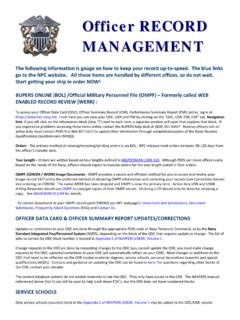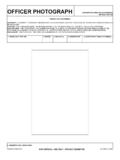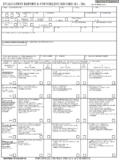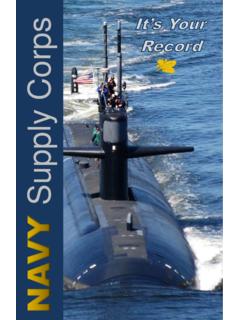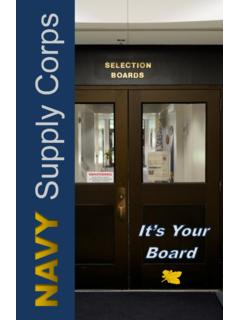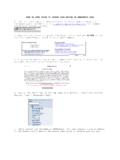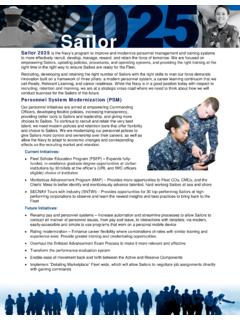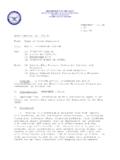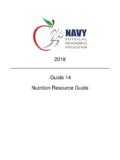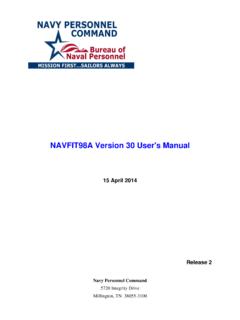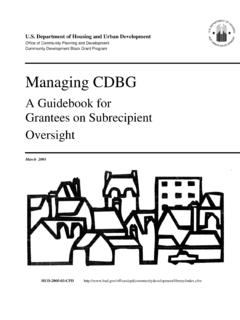Transcription of (PRCO) Handbook - U.S. Navy Hosting
1 Physical Readiness Control Officer (PRCO). Handbook Physical Readiness Program Fit to Fight! Updated: March 2017. Table of Contents Page Introduction . 4. Chapter One - Roles and Responsibilities of a PRCO . 5. Introduction of the PRCO Position .. 5. Primary vs Collateral .. 5. Principle PRCO Functions .. 6. Meeting Physical Readiness Program Objectives .. 7. Supporting Subordinate Commands .. 7. Chapter Two - Instructions and Guidance .. 8. Department of Defense (DoD) Policy .. 8. Navy Policy .. 8. Physical Readiness Program Instruction (OPNAVINST ) .. 8. OPNAVINST .. 8. Physical Readiness Program Operating Guide (OPGUIDE) .. 8. How To Guides . 9. Chapter Three - Understanding the Physical Readiness Program .. 10. Physical Readiness Program Purpose 10. Major Elements . 10. a. Physical Training Uniform (PTU) .. 10. b. Command/Unit Physical Training (PT) .. 10. c. Physical Fitness Assessment (PFA) 10. d. Fitness Enhancement Program (FEP) . 11. e. ShipShape 11.
2 F. Dietitian Resources .. 11. g. 5-Day Command Fitness Leader Course (CFL) Certification Course . 11. h. 2-Day CFL Seminar .. 12. i. Documenting PFAs .. 12. Chapter Four - PFA Policy Overview .. 13. PFA Cycles Defined . 13. CFL .. 13. PFA Notification 13. PFA Participation Requirement 13. PFA Failure 13. 1. Table of Contents (cont'd). Body Composition Assessment (BCA) Participation 13. Physical Readiness Test (PRT) Participation 14. Authorized Non-participation Justifications . 14. Unauthorized Absence (UA) from the PFA . 15. Sailors Serving with the Marine corps (USMC) . 15. Pregnant Servicewomen 15. Transferring Members with two or more PFA Failures .. 15. Drilling Reservists PFA Failures .. 16. Restrictions for Members with One PFA Failure 16. Promotion and Advancement Restrictions 16. Medical Waiver Policy .. 17. Chapter Five - PFA Administrative Separation (ADSEP) Policy and 19. ADSEP Policy .. 19. Mandatory ADSEP .. 19. ADSEP Timeline for Enlisted Member.
3 19. Officer ADSEP . 19. Non-Probationary Officer . 19. Probationary Officer . 19. ADSEP Package .. 19. Readiness Waiver .. 19. Timeline . 19. Waiver Expiration .. 20. PFA ADSEP for Members with Over 18 Years of Service .. 20. a. 18 (or more) Active Years of Service . 20. b. Members with Greater than 20 Years or More of Service . 21. c. Selective Reserve (SELRES) and Voluntary Training Unit (VTU) 21. Chapter Six Physical Readiness Information Management System (PRIMS). Overview .. 22. PRIMS . 22. PRIMS Database Sources . 22. a. Navy Standard Integrated Personnel System (NSIPS) .. 22. b. Navy Personnel Database (NPDB) 22. c. Inactive Manpower and Personnel Management Information System (IMAPMIS) .. 22. d. Enlisted Assignment Information System (EAIS) / Officer Assignment Information System (OAIS)/ Online Distribution Information System (ODIS) / Career Management System/Interactive Detailing (CMSID).. 22. e. Recruit PFA Record .. 22. 2. Table of Contents (cont'd).
4 Chapter Seven Working with PRIMS 23. PRCO .. 23. Audit Request 23. Learning PRIMS .. 24. PRIMS Reference Guide .. 24. PRIMS Menus .. 25. Administrator Message .. 25. Command Tab .. 26. Command Reporting Screen .. 27. Member Tab .. 29. Member Reporting Screen .. 31. Admin Tab 32. Help Tab .. 33. FEP Screen .. 33. Nutrition Screen .. 34. References List . 34. 3. Introduction This Handbook is to be used as a companion to OPNAVINST series. It does not mandate policy nor does it amend current policy. It is structured to provide the Physical Readiness Program Control Officer (PRCO) with readily available information concerning program policies and requirements. Physical fitness is a vital measure of readiness and the Navy is making great strides with implementing initiatives designed to help improve the Physical Fitness Assessment (PFA). success rate. The PRCO is in the best position to spot potential mission readiness issues concerning physical fitness of commands within their Area of Responsibility (AOR).
5 Early intervention by the PRCO is key to the readiness of the most capable naval force on the planet today. The Physical Readiness Program office encourages feedback about this guide. Please provide feedback to: Physical Readiness Program Office 5720 Integrity Drive Millington, TN 38055-6020. Email: 4. Chapter One Roles and Responsibilities of a PRCO. Introduction of the PRCO Position As the Navy remains focused on performance and enhancing the physical fitness of our Sailors, compliance and accountability issues are becoming an increasing concern. In short, the entire Navy suffers if personnel are not held accountable to the physical fitness standards established in the Physical Readiness Program. The PRCO assists Echelon II and III commanders by ensuring commands within their respective AOR are effectively managing a robust Physical Fitness Program. This position will assist both AC and RC Component personnel in maintaining the level of physical fitness required to support mission readiness.
6 PRCOs are strongly encouraged to complete the CFL 5- Day Certification Course. CFL Course dates can be found at: ( Primary vs. Collateral Duty In some cases, the PRCO will be a primary duty, but in most cases, it is a collateral duty position. The PRCO position is intended as a management position. The PRCO will be assigned the Echelon access (read-only) to the PRIMS for all UICs in their AOR. To effectively execute PRCO duties, the PRCO will not be able to serve as a CFL. Due to database security functionality, Echelon access will override all other access permissions. 5. Principle PRCO Functions The PRCO has the administrative oversight of the Physical Readiness Program for all commands within their respective AOR, advises the Echelon commander on the status of command Physical Readiness Programs, and maintains quality assurance over all program elements under their cognizance. Specifically, the PRCO will: a. Be pay grade E-6 or above, an officer, or a civilian employee GS-9 or above.)
7 B. Advise commanders on Physical Readiness Program policy and compliance for subordinate commands. c. Serve as the assigned point of contact for direct interaction with the Physical Readiness Program Office on all compliance issues/reporting. d. Assist in the coordination of on-site reviews and identify training shortfalls of subordinate command's Physical Readiness Programs. Coordinate with the Physical Readiness Program Office. e. Ensure Immediate Superior in Command (ISIC) inspections are conducted on subordinate commands, as necessary and inspections are conducted in accordance with Operating Guide 2. (Inspection and Command Self-Assessment Guide). f. In consultation with Enlisted Community Managers (ECMs), respond within 28 days of receipt of a waiver for readiness (readiness waiver) request. g. Maintain oversight of all administrative board retention requests to Commander Navy Personnel Command (CONAVPERSOM) for enlisted members with two or more PFA failures in most recent 3-year period.
8 H. Maintain oversight of all officer separation requests to COMNAVPERSCOM for officers with two or more PFAs in most recent 3-year period. i. Review all official correspondence and formal administrative complaints regarding Physical Readiness Program concerns. Forward all copies of responses to the Physical Readiness Program Office. j. Submit reports/information, as requested, from the Physical Readiness Program Office and COMNAVPERSCOM (PERS-8) on subordinate commands program compliance and trend analysis. k. Provide official ( , DOD, SECNAV, OPNAV, BUMED, and CNIC) guidance on Physical Readiness Program related issues and health and wellness promotion program information. l. Encourage support of local ShipShape and other Bureau of Medicine and Surgery (BUMED). endorsed health, nutrition and wellness related programs. 6. m. Encourage support of local Morale, Welfare, and Recreation (MWR) fitness and nutrition events and programs. n. Shall Attend at least one CFL Seminar every twelve months.
9 Meeting Physical Readiness Program Objectives In support of Physical Readiness Program objectives in OPNAVINST series and the associated operating guides, the program consists of Major Claimants, TYCOMS regional commanders, PRCOs, command leadership, CFLs, ACFLs and PRCO's and they should become familiar with the current partnerships established in the Physical Readiness Program: a. The Physical Readiness Program Office provides program management to include policy oversight, enforcement, standards, and quality assurance of CFL certification, ADSEP waiver processing and waiver compliance, management of CFL curriculum, and accession point training. b. Commander, Navy Installations Command (CNIC) conducts the 5-day CFL certification courses Navy-wide and provide the expertise of fitness specialists to the Fleet. c. BUMED provides policies and procedures to ensure Servicemembers (who have body composition and/or physical fitness challenges) are properly screened and referred for evaluation, as necessary.
10 BUMED provides the Medical Reporting Readiness System (MRRS). feed to PRIMS on a weekly basis, which automatically pushes PHA, PDHA and PDHRA date information to individual PFA records. d. The ECM/Officer Community Managers (OCM) serves in an advisory role for each Echelon III command. Echelon III commanders will coordinate with appropriate ECM/OCM. before making a final determination concerning personnel readiness. e. Officer and enlisted community managers manage all rating personnel and screen all Career Waypoints (C-WAY) requests to ensure Sailors meet the PFA transfer eligibility requirements for permanent duty orders. f. Personnel Support Detachment/Personnel Office (PSD/PERSOFF) electronically transmit administrative warnings to the Service member's Official Military Personnel File (OMPF). Supporting Subordinate Commands The PRCO is responsible in assisting the Physical Readiness Program Office in providing expert advice to CFLs on all matters relating to the Physical Readiness Program.
